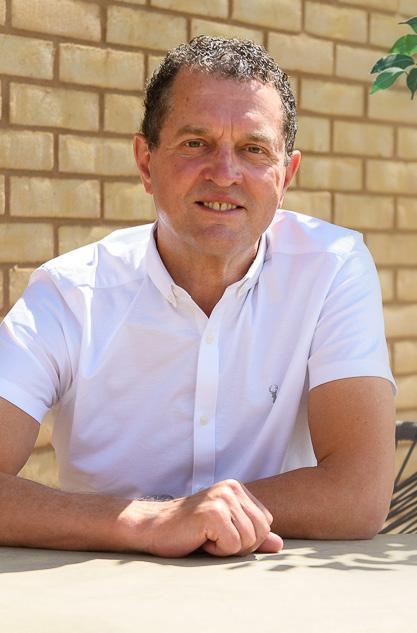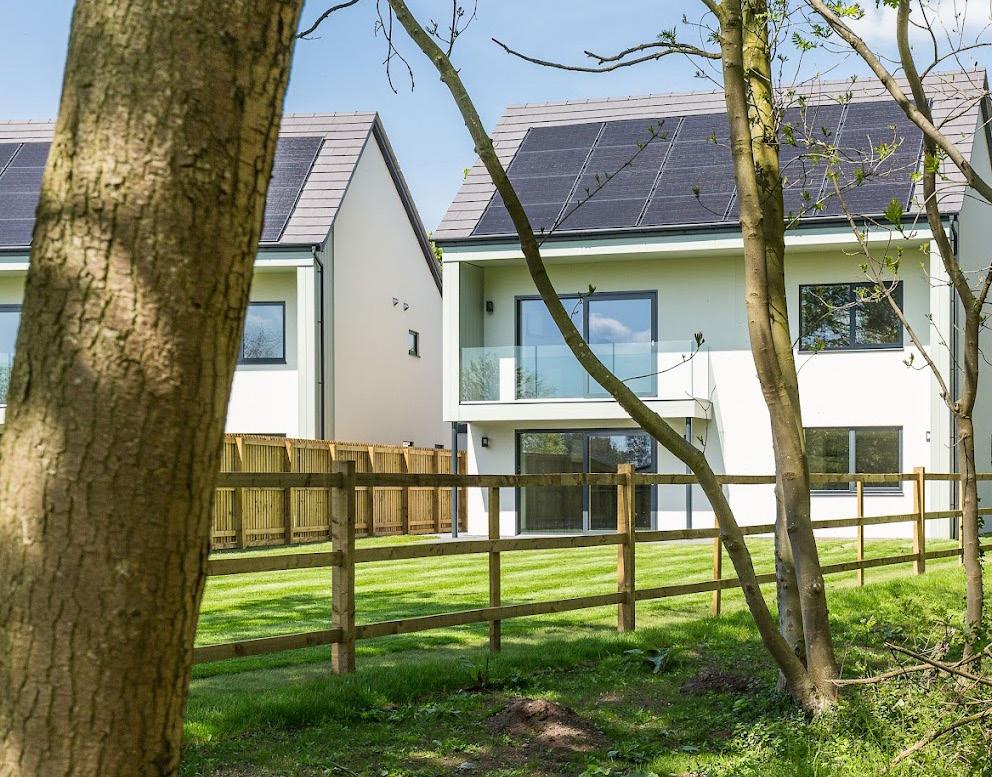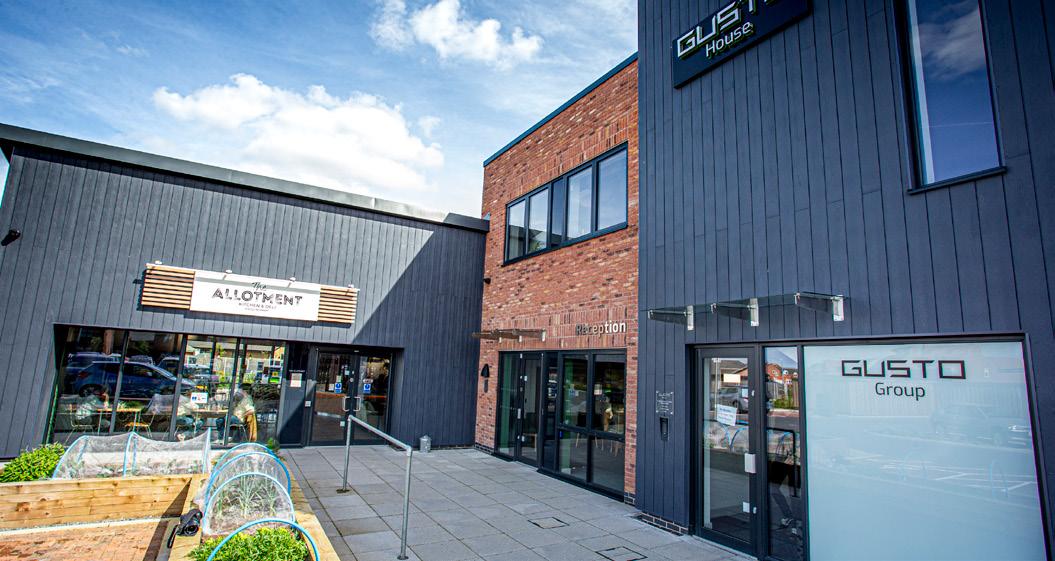

Driving the Future of Renewables with MCS


The Race to Retrofit: Can SHDF Wave 3 and Pas2035: 2023 provide the way forward?

Delivering A Better Outcome For Thanet’s Residents

Social Housing Decarbonisation Fund, Wave 3 Bid: How Can Social Landlords Utilise Their Funding Wisely?

Exploring Partnerships, Politics, and Net Zero Progress

Household Energy Bills Cut After £1.5m Retrofit Project

Previous

FOREWORD
Welcome to the latest edition of Housing Industry Leaders Magazine, a premier source of insight and innovation for professionals shaping the future of the housing sector. As we navigate a rapidly evolving landscape, marked by technological advancements, shifting economic conditions, and changing consumer preferences, our industry stands at a pivotal crossroads.
This issue delves into the themes that are redefining our field. From sustainable building practices and smart home technologies to urban development trends and policy changes, we aim to provide a comprehensive overview that equips you with the knowledge to stay ahead in this dynamic environment.
This issue delves into the themes that are redefining our field. From sustainable building practices and smart home technologies to urban development trends and policy changes
Floyd March Editor
Paul Rose Graphic Designer
Hannah Wintle Multi Media Journalist
THE RACE TO RETROFIT: CAN SHDF WAVE 3 AND PAS2035: 2023 PROVIDE THE WAY FORWARD?

The previous government set ambitious climate change targets that mean around 27 million homes will need to be retrofitted by 2050 to reach net zero, and we expect the current government to continue to pursue similar targets with Social Housing Decarbonisation Fund (SHDF) Wave 3.
While necessary, retrofitting at scale is no easy task, and the retrofitting process comes with its challenges.
PAS2035 goes a long way to addressing these challenges by creating a standardised process, but can a one size fits all approach work with the individual needs of each property?
Carl Yale, regional refurbishment director at Lovell, recognises that huge progress has been made over the past few years and while PAS2035 quality standards are undoubtedly important, retrofit will never be a simple process.
These challenges and an appetite for the sector to develop should be considered if we are to reach an effective solution.


GETTING TO NET ZERO
The UK has some of the oldest and most energy inefficient housing stock in Europe, and many homes are no longer fit for purpose when we consider the net zero targets that have been set.
To meet these targets, we need to be retrofitting at scale and pace, and a huge effort is needed with social housing in particular, but this is a complicated, time-consuming process.
Following a standardised process is one way to address the complications that can arise with retrofit and to ensure quality standards are met, as implementing the appropriate energy efficiency measures at the correct time and in the correct sequence should reduce those unintended consequences.
FINDING A SOLUTION
PAS2035 was introduced by the British Standard Institution to ensure the quality of deep retrofit work with greater emphasis on designed details and interfaces of measures.
A retrofit coordinator is appointed to ensure compliance with each step of the process, including a thorough retrofit assessment and technical surveys, resulting in a bespoke retrofit plan, which takes into consideration the individual needs of the property.

THE PROBLEM WITH PAS2035
There is still a lack of retrofit knowledge across the industry which poses an initial problem, as many of the operatives on these projects don’t understand the aims, risks or benefits of the measures being implemented.
When undertaking a retrofit project using PAS2035:2023 the process is clunky and can become expensive and time-consuming. This does not support large scale retrofit projects which are under strict timescales and short stop-start funding windows.
A huge amount of planning and coordination goes into the process before the retrofit work can even begin, with intrusive surveys and detailed designs. PAS2035:2023 is resource heavy and has significant administration and compliance burdens. If the compliance documentation cannot be provided, then measures cannot be lodged, and funding can be lost.
A huge amount of planning and coordination goes into the process before the retrofit work can even begin
The ’cost of compliance’ for PAS2035:2023 is in some cases deterring social landlords from bidding for SHDF funding, as the additional costs are disproportional to the measures installed and the funding available.
The initial principles of PAS2035 were to create a quality framework for deep retrofit. However, with this perceived burden and the short-term targets to ensure social housing are EPC C by 2030, we are seeing many landlords ignore the ‘worst first and fabric first’ principles and instead installing solar PV to gain enough Standard Assessment Procedure (SAP) points to reach EPC C by 2030. ‘Hard to treat’ solid wall properties are being deferred, to be dealt with another time.
Engaging with residents and ensuring that they ‘buy-in’ to the process is also vital. Continual surveys and assessments being carried out in the home can lead to ‘survey fatigue’ and in some cases residents can drop out of the scheme, meaning substitute properties will then need to be sourced, and the whole process must begin again.


THE WAY FORWARD
Ensuring we have a successful approach to retrofit is critical if we are to future-proof our homes. While PAS2035:2023 is a great starting point, there is still work to be done in the industry to consistently meet the standards needed, but also to guarantee complete compliance.
The inflexibility of PAS20235:2023 is not always practical and there is no room to accommodate changes of plans that can put schemes at risk. Complex and inflexible funding arrangements with a heavy burden of bidding and reporting, and a reliance on unreliable stock data, are a challenge. When combined with procurement routes that are single stage and not aligned to the PAS2035:2023 process the challenge becomes harder.
We would like to see a more holistic approach to funding that is more flexible to support the actual measures that are needed. An appropriate approach to individual homes and not just those that are deemed better value for money.
The skills gap is another ongoing issue for the industry, but many training providers are now focused on upskilling in retrofit, which is a positive step forward.
Continuing to build these skills will give those working in the retrofit arena more experience and confidence, which will in turn improve the quality and speed at which these projects can be carried out, something which we cannot afford to be delayed.
While PAS2035:2023 is a great starting point, there is still work to be done in the industry to consistently meet the standards needed
Progress has also been made in the sector with end-to-end retrofit solution providers sharing best practice and lessons learned, investing in in-house dedicated compliance teams to ensure full compliance with the sometimes-complicated PAS2035:2023 process.
Specialist PAS2030:2019 certified supply chains are also developing and increasing their capacity to deliver retrofit at scale, but there is still a long way to go to achieve the ambitious target of netzero by 2050. With improved consistency in data, funding, procurement and long-term pipelines, we will overcome the challenge.
Lovell, part of Morgan Sindall Group plc, is a leading provider of partnership and open-market housing.
The company has expertise in housing-led regeneration including new-build, affordable and build to rent, open market housing, refurbishment and retrofit, later living and strategic land. With offices across England, Scotland and Wales, Lovell offers a full range of residential solutions to its partners as both contractor and developer.
Morgan Sindall Group plc is a leading UK Construction & Regeneration group with annual revenue of £4.1bn, employing around 7,700 employees and operating in the public, regulated and private sectors. It reports through six divisions of Construction, Infrastructure, Fit Out, Property Services, Partnership Housing and Urban Regeneration.
Social Housing Decarbonisation Fund, Wave 3 bid
How can social landlords utilise their funding wisely?

Andy Sutton, chief innovation officer and co-founder at Sero, talks through his thoughts to help social landlords make sense of the next wave and how they should respond if they are to scale up.
SURFING WAVE 3
For English social landlords, attention will be turning to the third round of the Social Housing Decarbonisation Fund (SHDFw3), which promises to dole out £1.25bn over the next 3 years. Inevitable bureaucratic processes aside, the draft guidance shows a cleverly constructed scheme hiding in plain sight, for those that stop to look. Those that don’t might miss the point, and the funding.

A really key point to register is that the housing industry and government can’t fund all the improvements needed to reach net zero. Fact. To make the most of the funding we need to find smart ways of addressing the shortcomings. The good news is this can be done!

PLUGGING THE FUNDING GAP
It is likely that around £20k of the total funding is already in your maintenance budgets for end-of-life replacements, and perhaps £10k will be willingly leant to you by the private sector as long term secured investment. Whilst that doesn’t add up to the whole amount, throw in a little price reduction on key technologies through scale and innovation and it might just balance in time.
However, the hidden catch is that this only works if you spend the right money on the right measures - private finance won’t fund intangibles and does need a pay-back, whereas maintenance is focused on existing elements in the home. The grant can be spent more widely but do so unwisely and you’re closing out some of your funding.
The funding works to recognise the maintenance point too. Fifty percent of the spend will have to come from your own pockets through match funding, and that almost certainly means forward maintenance. SHDFw3 will grant fund you up to typically 7.5k, giving you a total spend per home of £15k with your 50% match funding.
The answer is to stop thinking about SHDFw3 as a ring-fenced project, where you aim to get all your selected homes to a certain milestone at the same time. Instead, build a process in your organisation that lets you assess every home in your portfolio around its individual condition/needs, its residents, and your maintenance schedule/budget.
BALANCING FABRIC FIRST AND FABRIC FIFTH
You may have seen the debate on LinkedIn around fabric first and fabric fifth? It highlights how technical advances in heat pumps, together with price reductions and decarbonisation of the grid could be a better solution than more expensive and disruptive insulation of solid walls.
Net zero needs to scale up more quickly. This is clearly reflected in the SHDF W3 guidance which starts to show where that balance fallstypically modest fabric improvements and inherent ventilation - combined with the electrification of the home. Reams of data now supports this as a more nuanced approach rather than old mantras stolen from a new build. This more individual and balanced approach should provide a modest reduction in residents’ bills at an achievable capital cost.


Net zero needs to scale up more quickly. This is clearly reflected in the SHDF W3 guidance
SUBMIT EXPENSIVE EXTERNAL OR INTERNAL WALL INSULTATION AT YOUR PERIL
SHDF W3 emphasises over and over the importance of value for money and quietly drops the previous emphasis on fabric improvements.
I might also add that there may be homes where external or internal wall insulation are really needed to address fuel poverty, damp and mould - but these should be the exception rather than the majority of a successful SHDF application and wider net zero strategy.
For most homes this means getting the basics like loft insulation, appropriate ventilation and robust doors and windows in place.
The focus on decarbonisation, especially of heat, is clear. Whilst each home will need to be assessed, this probably means either a heat pump or PV & battery are the “technology” element of the bid. Of the two, there’s a clear route to private finance for PV & batteries, and only a few promising pilots for heat pumps. Which may mean the heat pump is the better grant spending for now - though don’t misunderstand, PV & battery is absolutely part of the solution for many homes in the UK, it’s just not necessarily the best use of the grant right now given other funding is available.

WHAT DOES SHDFW3 REALLY WANT TO ACHIEVE?
I’d suggest it wants to see a systemic approach that shows you can find your homes below EPC “C” and their forward planned maintenance budgets for elements coming to the end of their life - boilers, windows, fans, etc. across your whole stock. For bigger stocks, include how you’ll look to priority areas or other key metrics. Show that you have a process that matches the maintenance money against any available grant. Typically add around 450mm loft insulation, smarter heating and ventilation, with plans for how you will electrify heat sources and install better doors and windows as they’re nearing their end of life.
At the same time, separately financed but as a part of a coordinated whole house plan, show the roll out of solar PV & battery using patience, ethical finance and share the savings with your residents to repay it. The different funding sources doesn’t mean you can’t deliver this through the same programme on the ground, it just minimises the number of visits to each home.
DELIVERING THE BEST OUTCOME
The landlords we’re working with are using all the above approaches to create the most streamlined investment available. We pick the low hanging fruit to maximise grant funding, we pair retrofit plans with investment budgets, and we avoid spending capital grant and investment budgets on things that the market will finance, for example PV & battery storage.
The answer is to stop thinking about SHDFw3 as separate from day-to-day workloads. Begin to adjust your delivery so you can do this as ‘business as usual’ for the next decade or two.
The different funding sources doesn’t mean you can’t deliver this through the same programme on the ground, it just minimises the number of visits to each home

ENERGY
CUT AFTER £1.5M RETROFIT PROJECT

Almost 300 households in Dumfries will continue to enjoy warmer homes and lower energy bills this autumn and winter thanks to a £1.5m retrofit project led by Riverside Scotland.
The seven-figure investment by Riverside Scotland has been spent to future proof and improve the thermal efficiency of the 294 homes to a high C EPC rating.
The comprehensive works programme carried out by Glasgowbased Union Technical Services in 2023 included the installation of a cutting-edge internal wall insulation system specifically designed for solid wall sandstone properties, which reduces heat demand and lowers energy bills.
ANALYSIS UNDERTAKEN BEFORE AND
AFTER THE WORKS HAVE SHOWN THAT THE MEASURES INSTALLED COULD REDUCE ENERGY BILLS BY UP TO 40%*
Using up to 40% less heat would equate to a saving £186** on the current average annual gas bill of £603 per year.
New ventilation systems were fitted to improve air quality while eliminating damp and mould issues, and replacement cavity wall insulation and a liquid damp proof course were applied to further enhance energy efficiency and protect the homes.
Riverside Scotland also equipped the homes with Switchee smart thermostats. The devices optimise household energy use, resulting in up to a 17% reduction in heating bills and allow tenants to control their energy usage remotely when away from home.
The project also contributes towards the Scottish Government’s target of becoming net zero by 2045.
As part of the work Union Technical Services has also given £5,000 to Riverside Scotland to fund further improvements to the estate’s flourishing community garden.
One local resident who has lived in Dumfries for 30 years, said: “I was really pleased when I heard that Riverside Scotland was upgrading and investing in the older houses on the estate like mine.
“The works were no hassle, and my home feels cosier. With winter approaching and ever rising energy costs I am looking forward to a warmer home that’s cheaper to run.”
Riverside Scotland has been housing and supporting people in local communities across South West Scotland for 30 years and in 2011, became part of The Riverside Group - one of the UK’s leading not-for-profit social housing and regeneration organisations, owning or managing around 76,000 homes across the UK.
ECO IMPROVEMENT WORKS GET INDUSTRY RECOGNITION
In recognition of its ECO improvement works to futureproof the 294 homes, Riverside Scotland was named Housing Association of the Year at the 2024 Scotland Energy Efficiency Awards. The prestigious award recognises exceptional commitment to energy efficiency within the region.
Heather Duff, Head of Asset and Sustainability at Riverside Scotland, said: “Increasing the energyefficiency of our customers’ homes to make them warmer and more cost effective is one of our top priorities, and we aim to bring all our homes across Riverside up to a minimum EPC Band C by 2030.
In recognition of its ECO improvement works to futureproof the 294 homes, Riverside Scotland was named Housing Association of the Year at the 2024 Scotland Energy Efficiency Awards.
“We’re really proud of the work we’re carrying out which supports our customers as they continue to navigate cost-of-living, as investment of this kind means our tenants will benefit from the energy savings each and every winter.
“Riverside Scotland remains dedicated to improving our customers’ homes over the coming years through a whole-house retrofit approach.”
Riverside is also committed to efforts aimed at ending the housing crisis. Having seen firsthand the impact of energy bills on customers, the national provider is calling on the support of the Government in accelerating the decarbonisation of existing social housing through expanding funding to enable housing associations to provide energy efficient, affordable homes.

RIVERSIDE SCOTLAND HAS BEEN HOUSING AND SUPPORTING PEOPLE IN LOCAL COMMUNITIES ACROSS SOUTH WEST SCOTLAND FOR 30 YEARS
In 2011, Riverside Scotland became part of The Riverside Group, one of the UK’s leading not-for-profit social housing and regeneration organisations, owning or managing around 76,000 homes across the UK.
Since then, we have grown and developed our services, transforming lives and revitalising neighbourhoods through ambitious new-build programmes and improvements and support for our existing customers.

People are at the heart of Riverside Scotland –the people who we provide homes to, the people we support in the communities we serve, and our skilled and experienced team of employees.
We are committed to doing better, for our customers and our people. We are also focused on playing our part to tackle homelessness and help the people who need us most.
In 2021 Riverside Scotland and Veterans First Point, which is part of the NHS, set up a ‘service level agreement’ to support veterans to maintain their tenancies.
The actual amount of energy households will save will depend on many factors including how cold the winter is, how many people are in each household and what kind of fuel a household uses to heat their home.
People are at the heart of Riverside Scotland – the people who we provide homes to, the people we support in the communities we serve, and our skilled and experienced team of employees
The average gas bill in the UK as of 1 July 2024 is £603.72 per year (without factoring in the annual gas standing charge). Government analysis estimates that heating is estimated to account for 77.2% of total gas use. Using up to 40% less heat would equate to a saving £186.43 on the average annual gas bill of £603.72 per year.

Driving the Future of Renewables with MCS
MCS (Microgeneration Certification Scheme) is the UK’s quality mark for small-scale renewable energy. They set standards that allow for the certification of products, installers and their installations – giving everyone confidence to invest in renewable technologies.
Ian Rippin, CEO at MCS, reflects on the progress the Scheme has made so far, the current work MCS is doing to engage local authorities in the green energy transition, and what the future of renewables looks like with the upcoming redevelopment of MCS.
MCS product and installation standards define how small-scale renewable technologies, such as heat pumps, solar PV and battery storage, are tested, designed and installed. They ensure the efficiency, safety and reliability of renewable products and installations, which is key to driving consumer confidence in home-grown energy.
MCS
Certification(Microgeneration
Scheme) is the
UK’s
quality mark for small-scale renewable energy

THE STATE OF RENEWABLES
The latest data from the MCS Data Dashboard shows that more than 1.9 million certified technologies have been installed across UK homes and small businesses since 2008. Heat pump installations have surged in 2024, with average monthly installations rising by 39% compared to 2023, which was itself already a record- breaking year for the technology. With over 40,000 heat pumps installed in 2024 so far, this year is on track to set a new record, although more progress is needed if we are to reach the government target of 600,000 heat pump installations annually by 2028.
Battery storage is another technology that is seeing a record number of installations. There have now been more than 17,000 certified battery storage installations all-time, with over 12,000 being installed in 2024 alone. We recently added battery storage installation and contractor data to the MCS Data Dashboard, helping industry professionals, policymakers, installers and consumers to track and measure the progress of this technology.
When it comes to Solar PV, installations remain steady, with 13,237 solar PV installations in August 2024, bringing the year-to-date total to over 129,000. It highlights how consumers are continuing to take advantage of free energy from the sun, combining with other technologies to decarbonise their homes.
MEETING THE DEMAND FOR RENEWABLE ENERGY
The latest data shows that consumers are becoming increasingly confident in adopting renewable systems for their homes. But if we are to meet the growing demand, we need to ensure we have a strong, renewable workforce that is capable of delivering high-quality installations across the UK.
That’s why we’re helping electricians transition into the renewable energy sector. MCS is funding the Solar Installer Accelerator programme, launched in partnership with Green Economy. The programme aims to upskill electricians across Greater Manchester with the required qualifications and skills to become MCS certified for solar PV and battery storage, whilst also providing business support from Green Economy. Programmes like this are crucial for supporting the growth of skills and contractor numbers within the renewable industry.
ENGAGING LOCAL AUTHORITIES
Local authorities and housing associations can also play a key role in the UK’s switch to cleaner and greener energy. It’s important for them to understand the benefits of renewable technology and the funding opportunities available to support their community’s transition to renewables.
The Warm Homes Social Housing Fund (Wave 3), formerly known as the Social Housing Decarbonisation Fund (SHDF), is designed to improve homes that use a lot of energy and have a low Energy Performance Certificate (EPC) rating. Local authorities, combined authorities and registered providers of social housing can apply for the funding that aims to deliver warm, energyefficient homes, reduce carbon emissions, tackle fuel poverty, support green jobs, and develop the retrofit sector. Renewable technologies, such as heat pumps, are included in the funding and are required to be installed by MCS certified installers to ensure quality. You can read more about the fund here.

The Warm Homes Social Housing Fund (Wave 3), formerly known as the Social Housing Decarbonisation Fund (SHDF), is designed to improve homes that use a lot of energy and have a low Energy Performance Certificate (EPC) rating.

As the demand for home-grown energy increases, more consumers are interacting with the renewables industry

REDEVELOPMENT OF MCS
As the demand for home-grown energy increases, more consumers are interacting with the renewables industry, and as the UK’s quality mark for the design and installation of renewable energy technologies, MCS is set to play an increasingly important role in ensuring consumers who invest in small-scale renewables have the best possible experience.
This is why we’re launching the redeveloped MCS in January 2025 – a Scheme designed by industry, for industry, emphasising high-quality installations and with consumer protections at its core.
We want to make it as easy as possible for installers to understand how they can ensure compliance with MCS standards and to continue doing what they do best, which is delivering high-quality installations to their customers. The redeveloped Scheme will therefore move away from paperworkheavy assessments towards an emphasis on ‘delivered quality’. Compliance assessments will focus on capturing the evidence that an installer’s quality processes and controls are delivering installations that work effectively, are technically sound and are compliant with our standards.
The redeveloped Scheme will also strengthen consumer protections and become a single point of contact for consumers in the rare case they wish to escalate their complaint. There will be a clear route that involves MCS working with the installer to understand the nature of the complaint and how best to resolve it. It’s a change that will improve consumer protections by providing greater transparency across the sector.
With greater oversight, the redeveloped MCS will play a pivotal role in raising standards across the industry and increasing consumer confidence in renewables, which is key to driving uptake.
For more information on what the new Scheme means for installers, visit mcscertified.com
To explore renewable technology uptake near you through the MCS Data Dashboard, visit datadashboard.mcscertified.com

DELIVERING A BETTER OUTCOME FOR THANET’S RESIDENTS

Thanet, tucked away in the corner of East Kent, enjoys a beautiful coastline and a buoyant tourism trade. With several coastal towns, it has areas of real vibrancy as well as some areas of deprivation. However, its housing challenges, with the gap between demand and supply growing, are similar to many areas in the county, the south east and the country as a whole.
With 1,500 households on our Housing Register and with around 300 households in temporary accommodation (TA) at the time of writing, Thanet District Council stands out as a thought leader for innovating new ways to secure new homes.
This was prompted by one of the challenges the sector faces - registered providers (RPs) backing away from the section 106 (s106) market as they focus on meeting new compliance regulation, meeting new tenant satisfaction measures and decarbonising their own stock.
Last July, with solid political backing, the council embarked on an ambitious accelerated delivery programme of building and acquiring at least 400 homes by 2027.
The council has already contracted to acquire or build over half of those homes. Subject to approval, these deals will take us right up to that 400-home target in just over one year.
By working closely with local developers and understanding the development on our doorstep, we are making the housing crisis a problem everyone wants to solve. Local developers are proud to play their part, and each acquisition dispels the myth that the majority of homes being created in our district are for ‘outsiders’ moving in.
Furthermore, the council’s local lettings plans mean that 50% of the new homes will be let to applicants on the housing register and 50% will be let to applicants in TA who are in a position to sustain a secure tenancy. This will reduce TA numbers - which have remained stable for the last quarter - in time, and thus reduce the overspend in the council’s General Fund.
Of course, it takes a team of people to build or buy a house. Without colleagues in Democratic Services, meetings wouldn’t be scheduled to agree to the deals, without Legal and Planning there would be no s106 agreements ring-fencing homes as affordable housing.

Without Finance, the viability would not be sound and without colleagues in management, maintenance and repair teams, there would be no holistic direction for the maintenance and management of the homes.
Developer relationships are of course key to delivering the council’s ambitions, and the ongoing partnership with Barratt David Wilson Homes (BDW) is a case in point. One of the benefits in engaging with BDW has been access to their Discovery House. Often the council will acquire homes late in the day, once properties are beyond the first-fix stage and colleagues in the management, maintenance and repair teams have no idea what is behind the walls.
However, with the Discovery House, officers and elected Councillors have been able to see the inner workings of the BDW product.
Owning its own temporary housing stock reduces the impact of TA on the council’s General Fund and supportive management reduces the social toll on people placed in the homes. It also means a potentially shorter wait before moving into a secure tenancy. A recent acquisition will double its number of council-owned TA homes, a better outcome for everyone.
However, it is the council’s Phase 4 new-build programme that is really innovative. The council is delivering 49 EPC ‘A’-rated homes across four infill sites. These highly energy efficient units will deliver significant carbon emission reductions, reduced fuel bills for occupiers and ultimately safeguard against the risk of fuel poverty. From a futureproofing perspective, these homes will meet the highest energy efficiency standards possible and will not need costly retrofitting measures as they are well-prepared for future changes to building regulations.
Thanet District Council declared a climate emergency in 2019 and has a Corporate Priority to protect our environment, aiming to achieve Net Zero on council-owned properties by 2030
With advanced energy-efficient technologies, such as heat pumps, solar panels and Mechanical Ventilation Heat Recovery, these homes are likely to provide lower energy bills to occupants too. Smart home systems monitor humidity and provide invaluable data to ensure that these more airtight homes are not creating excessive condensation which can lead to damp and mould.
The house, which is freely open to the public (and in this case officers and Councillors), sees a semidetached property constructed to various stages in each room, with cutaway walls and ceilings.
Battens are clearly visible that show how cabling and plumbing are fitted. It offers a real insight into Barratt Kent’s fabric-first construction methods, and every visitor can see first-hand the design and construction process that transforms blueprint into reality.
Tallied with the Corporate Priority of delivering the housing we need, including TA (which has already seen the council renovate an office building into eight temporary homes), it can be clearly seen that Thanet District Council is working towards its targets.
These technologies do come at a cost however. Our Phase 4 programme is being delivered at a cost per square metre of over £3,000 compared with lower costs for homes with an EPC ‘B’ rating. But it shows what can be achieved by the public sector, and as our planning colleagues often say about meeting high standards, “If we don’t do it ourselves, how can we ask developers to follow our lead?”.
We are proud of our delivery programme - tackling the shortage of housing through new-builds and acquisitions. There is much momentum here in Thanet and such a positive, can-do attitude permeates throughout the authority. We are keen to learn from others and share best practice where we can. It is only by learning from each other and sharing our goals and ambitions that we can collectively tackle the external political, social and environmental factors that dominate our sector.
We are determined to give everyone the opportunity to live in affordable, high-quality accommodation and enjoy what our beautiful district has to offer.
Exploring Partnerships, Politics, and Net Zero Progress
With Steff Wright, Gusto Group
Q. Can you tell me more about Gusto Group?
I believe there’s a family element involved here, isn’t there?
We’ve got various family members involved in the business. My brother came and started working with me. He was very much more hands on, and I was the guy that was interested in the business side of it, so it was a good team effort, really. And we grew with friends working for us to start with, and then gradually you have to become more structured as a business, and then we are where we are now. We’re not a massive company, but we’re doing some quite interesting stuff in this space.
Q. What role do partnerships have to play in meeting net zero?
We’ve done a bit of soul searching over the last couple of years in terms of the direction of travel for the business, and it made me think about how we grow, and the decision was to grow through partnerships.


We’ve got a good experience in what we’ve done, and we can share that experience with other organisations who perhaps haven’t got that experience but have got the financial resources, the land, and the pipeline to grow.
I think, for a period of time, there hasn’t been enough enthusiasm for going over and beyond basic building regulations. Certainly there’s been very few drivers from the government to incentivise people to go over and beyond. But I think with the change of government we’ve had, there seems to be a different environment growing, and we think that we can help to play a role in that roll out because of the experience we’ve had. The best way for us to do that is through partnerships.
Q. What does the new government mean for low carbon construction? You’ve got an interesting insight here as you served as chairman of the Climate Party.


Yes, I did a spell as chairman of the Climate Party. We were a single issue party trying to get the message over that a faster transition to net zero and policies that drive that transition should be seen as good for business. The UK plc can and should deliver innovation, and the most important innovation that needs to be delivered is this fast transition to a more sustainable future.
I very recently stood down as chairman from the Climate Party, partly because, as much as politics is quite interesting and I’m pleased I’ve done it, I also don’t want to be party political. I’ve never been party political prior to my involvement in the Climate Party. And I do feel that this new government is more receptive to a faster transition to net zero, but they need to work with people that understand the route to that net zero economy.
Therefore, I don’t want party politics to sit in the way. I’m very, very keen to work with the government, work with any organisation that’s going to fast track this transition because it’s going to be good for business. It’s going to be good for the UK economy, and it’s something that we just have to get on with and do.



Q. You’re adopting an employee ownership style business model at the moment. Can you tell me more about that?
Well, as a business, we’re quite innovative in what we do, and I think that got to a point where I felt we needed to be a bit more innovative in the way we structure the business. So in the end, what I’ve decided to do is to transition the whole company into an employee ownership model. We’ve set a target date of April 2027 for us to become a 100% employee owned company. The reason I’ve set it three years hence is because I want to share the upside in growth, the growth of the company over that three year period, with all the staff. We’ve got everybody focused on growth, we’ve got everybody being rewarded by that growth at the end of the three year period, and then at that stage the company will be a wholly employee owned company.
Q. What is next for Gusto Group? Partnerships. And I think that’s the exciting thing, because we open ourselves up now to work with all sorts of different organisations. I would love to work with other employee owned organisations.
It’s about working with like minded organisers, by bringing our experience and our entrepreneurial outlook and ability to come up with solutions, to larger organisations that have got the financial clout in the land. I think that that’s where the exciting opportunities are going to come from.
I would love to build a utopian type of development, that brings all this together, where people almost pre-purchase into a development concept, before bricks even be laid, people that want to come together and live it. If we could live our lives in communities where we’ve all got a shared interest in the community that we live in, then I think our lives would have value added to them.
LISTEN TO THE FULL PODCAST ON SOUNDCLOUD









Theapplicationwindowfor the WarmHomes:Social HousingFund isnowopen.
APPLYNOW
Thiscompetitionwindowcloseson25/11/24,itwill provide fundingforprojects overthenextthreeyears (2025/26to2027/28).
The WarmHomes:SocialHousingFund offersRegisteredSocialLandlordsasignificantopportunityto decarbonisetheirportfolioswhiletakingresidentsoutoffuelpovertyforgood.Groundsourceheatpump technologyoffersunparalleledefficiencyandcarbonreductionthatcanachievethesegoals. Kensa’sexpertscanhelpyouidentify potential projectsanddevelopthebestfundingapplications.
1heatpumpsolution =upto2band EPCuplift Takeresidentsout offuelpoverty ReachyourNet Zerocarbontargets Achievethelowest lifecyclecost Scantobookyourfree 1-2-1orvisit kensa.group/whshf












Engaging with local authorities and housing associations delivering Scotland’s housing agenda
• Housing to 2040 – setting out the vision for housing
• Affordable home supply, continuing to work closely with partners to deliver affordable homes
• Building vibrant places, helping create places people want to live, work, and bring up families
• Reducing energy consumption in the home
• How innovative thinking and new technologies will shape the future
27 November 2024


Radisson Blu Hotel, Glasgow
